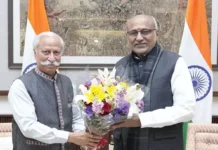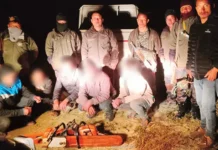[ Suresh Chandra Mohanty ]
Indian Home Minister Amit Shah during his recent visit to Namsai in Arunachal Pradesh most fittingly termed the state the “crown jewel of India.” From the vaguely territorial definition of North Eastern Frontier Agency (earlier known as North Eastern Frontier Tract), encompassing areas of the present-day Assam, Arunachal and Nagaland, to being a union territory on 20 January 1972 and subsequently being granted statehood on 20 February 1987, the state has come a long way in terms of a distinct ethno-cultural and geographic identity, development, infrastructure and prosperity. During my telephonic interaction with a number of service providers located across metro cities in India over the last year and a half, I was distressed to find many learned and so-called English-speaking intellectuals unaware of where Itanagar was and had a rather vague idea about Arunachal Pradesh as a state. Hence the deplorable ignorance of 24-year-old-YouTuber Paras Singh, from Punjab, with a Twitter following of 30,000, who made derogatory remarks not only about the people of the state but also racist remarks against a sitting MLA in May last year, is not exactly a case of one-off aberration and stereotyped perception of Northeast India. The subsequent clamour by over 30 organisations in the Northeast for inclusion of history and cultural knowledge about northeastern states in the educational curriculum thus has enormous merit. It is to the credit of the state police to have rounded him up within 48 hours and bringing him to Itanagar to face legal action.
Strategic significance
Arunachal Pradesh happens to be geographically the largest of the northeastern states with an area of over 83,000 sq kms, and shares borders with Tibet, Bhutan and Myanmar, nearly placing it at par with J&K in terms of geo-strategic importance. The border with Tibet, though defined by the McMahon Line (not recognised by China) has not been delimited, demarcated and delineated, leading to differing perceptions and frequent face-offs with the Chinese PLA at multiple points along the line of actual control. The border with Myanmar, though demarcated sans the trijunction between India, Myanmar and Tibet, is governed by peculiar dynamics of free movement regime (FMR) that permits population along the border areas on both sides to travel freely up to 16 kms from the international border with head loads as concession to ethnically linked population on both sides of the border. Given the presence of training and logistic camps of multiple insurgent groups close to the border in Myanmar, despite the Sunrise series of operations launched by Myanmar Army in 2019/20 in conjunction with Indian security forces, low intensity insurgency continues to fester. The internal situation in Myanmar since 1 February, 2021 and the involvement of Myanmar Army in internal security along with the dynamic situation in Nagaland has only aggravated the situation, leading to ungoverned border areas in Myanmar.
The peaceful border with Bhutan is marred by the Chinese territorial expansionism in the Doklam plateau to pose considerable threat to the narrow Siliguri corridor, the scene of the 73-day standoff in June-August 2017. It is also reported that areas of northern Bhutan have been encroached on by the PLA at multiple places to render depth to the vulnerable Chumbi valley, besides coercing Bhutan to resolve boundary dispute on Chinese terms.
Tawang is home to the second largest monastery of the Gelugpa sect of Tibetan Buddhism, next only to Potala in Lhasa. The Chinese claim of south Tibet, including most part of Arunachal Pradesh, is a partial manifestation of the linkages between the Buddhist monasteries. The special coordinator of US for Tibet visiting his holiness the Dalai Lama in Dharamshala on 19 May, 2022 must be seen in the context of the 14th Dalai Lama succession factor gaining momentum and China insisting on the reincarnation of the 14th Dalai Lama being approved by the communist regime. The issue is of considerable strategic significance for India, which houses the Central Tibetan Administration in exile. Sinicization of Tibetan Buddhism and recent efforts to recruit Tibetans into the PLA will have its strategic resonance for India, which must leverage the Dalai Lama factor to extract comparable diplomatic brinkmanship vis-à-vis China.
Arunachal Pradesh also acts as a gateway to the ASEAN countries as a geo-economic corridor to strengthen the ‘act east’ and the ‘neighbourhood first’ policies. The road leading from Nampong in Changlang district can be connected through Mandalay and Yangon in Myanmar, to Bangkok (Thailand), Phnom Penh (Cambodia), Ho Chi Minh City (Vietnam), as also further to Kualalumpur (Malayasia) and Singapore (Asian Highway 3, 2 and 1). This will help diversify the only trade route between Moreh and Mandalay. Incidentally, the Moreh road passes through the Chin state of Myanmar with significant Chinese influence. The alternative road through Nampong, besides enhancing connectivity and trade, will also provide redundancy.
The state not only provides strategic depth to the Brahmaputra valley and the rest of the NE states from the north but also provides multiple locations for long-range strategic vectors to target critical areas and infrastructure in Tibet. It has immense potentials for hydropower, tea, oil, tourism, especially adventure tourism, and forest produce. The recent finds of uranium reserves in the Menchuka valley only makes it a powerhouse.
Recent developments
Having been stationed at Itanagar over the last nearly 20 months and travelled extensively to far-flung areas both in the south along the Indo-Myanmar border and in the north along the LAC, I am a personal witness to the unprecedented development that has taken place. The infrastructure development in hitherto unconnected areas in terms of roads, bridges, foot suspension bridges, helipads, resuscitation of advanced landing grounds is rather unparalled. Besides the airport in Hollongi (Donyi Polo Airport) which is scheduled to be inaugurated on 15 August, 2022, fixed-wing air services to Pasighat and Tezu have been energised. Helicopter services to multiple district headquarters and tourist destinations including Mechukha, Anini, Tawang, Hawai, Roing and Yinkiong have been made more frequent and robust under the regional connectivity scheme. The proposed rail extension to Tawang, Pasighat-Parsuramkund and Aalo will further enhance trade and tourism.
There have been discernible improvements in the fields of education and healthcare. The state has an enviable literacy rate of 82.93 percent against the national average of 77 percent. The number of deaths due to Covid is one of the lowest, even amongst the small category states in terms of population. The personal and extensive involvement of elected representatives, including ministers, the executive and top-level bureaucracy has only provided further fillip to the pace of infrastructure development in the region. State ministers have not shied away from taking long and arduous journey to reach out to the population in remote locations. Over the last several months, there has been a deluge of central ministers, bureaucrats, doyens of private and public sector enterprises, educationists, legislators and sports enthusiasts visiting the state. Multiple levels of oversight, streamlining and accountability have enforced scrupulous adherence to mandated timelines for completion of projects, given the unpredictable weather conditions and reduction of pilferages. I have been a personal witness and participant in multiple videoconferences, site visits and coordination meetings to resolve inter-ministerial bottlenecks, supply chain disruptions and construction delays.
Border area development under the Vibrant Villages programme has been a focus area with Rs 249.12 crores being allotted for the purpose in 2021-22, while the state government has prepared a comprehensive plan for development of infrastructure in the border areas with Rs 4,000 crores. Three clusters of border area villages, one each in the eastern, central and western sector, have been identified to be developed as model villages with housing, connectivity, communication, healthcare, education and livelihood being the areas of impetus with an initial outlay of Rs 30 crores. The government has embarked on a decisive plan to prevent migration from the border villages through the Indo-China Border Development Legislators of Arunachal Pradesh Forum, aimed at devising plans and strategies to develop backward areas along the border. From one project Vartak of the Border Roads Organisation located in Tezpur (Assam), the state is now serviced by four projects from the westernmost district of Tawang to the southernmost tip of Longding. The environmental and forest clearances have been simplified by legislative procedures in keeping with infrastructure development plans. During the visit of home minister, projects worth Rs 1,180 crores were announced.
Ethnic cohesion
Despite being populated by over 26 major tribes and over 100 sub-tribes and strong ethnic affiliations, there is a pan-Arunachal identity and communities live harmoniously with each other through amicable consultative and cooperative mechanisms and have adopted democratic means to air their grievances. The recruitment into government jobs has been streamlined through the mechanism of the Arunachal Pradesh Staff Selection Board and the Arunachal Pradesh Public Service Commission, thereby addressing favouritism, dissent and enforcing transparency and accountability. It has also resulted in merit-based selection for various government jobs. The crime rate is one of the lowest in India as per the National Crime Records Bureau. Arunachalis are fiercely patriotic and one unique characteristic of the state that distinguishes it from the other northeastern states is the widely spoken Hindi language that not only makes it business- and tourist-friendly but also permits its seamless integration with the rest of the country.
Substance abuse & environment protection
There has been a hugely successful airgun surrender campaign to preserve the ecology and environment, which has resulted in surrender of nearly 2,200 guns, and one finds a discernible increase in the number and variety of birds even in a semi-urban city like Itanagar. The campaign against drugs has been sustained and vigorous, consequent to explicit instructions from the political hierarchy, and the state police have been hugely successful in reducing the menace.
Tourism
Having visited a number of European countries, I dare say that Arunachal Pradesh boasts of huge potential for tourism both from India and abroad (Dekho apna desh, and Dekho apna pradesh). The pristine beauty of rivers meandering through multiple gorges, breathtaking waterfalls of varied shapes, dimensions and intensities, evergreen forests with flora and fauna is simply unmatched. Each river valley starting from Kameng to Subansiri, Siyom, Siang, Dibang and Lohit are characteristically different in the soil conditions, flora, fauna and its distinctive tribal populace who preserve their unique customs and traditions. Many of the valleys are potential sites for adventure sports like bungee jumping, paragliding, zip lining, white water rafting, trekking, rock climbing and angling.
Arunachal Pradesh is a rare paradise on Earth in Northeast India. Our countrymen must endeavour to discover its pristine beauty, breathtaking landscape, unadulterated environment and acquaint themselves with its strategic importance. (Major General Suresh Chandra Mohanty is security adviser to GoAP.)



